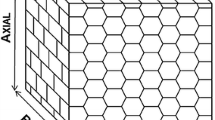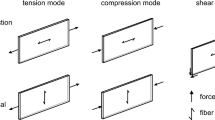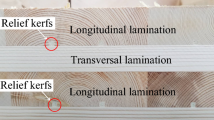Abstract
The behaviour of cork under three point bending stress in the radial direction was evaluated in relation to porosity (range 2.0–15.4%) and density (range 0.160–0.220 g cm−3). The study was made using water-boiled cork planks of two commercial quality classes (good and poor quality) collected at an industrial mill. Cork samples were cut with the largest dimension in two directions, axial and tangential, and with the load zone in the inner part and the outer part of the plank.
The stress-strain curves obtained in bending were similar for the different test specimens and similar to those observed for tensile tests in cork but the mechanical resistance of cork in bending was higher than in tension and lower than in compression. The direction of the internal stress in samples submitted to bending was a highly significant factor of variation. The curves showed an initial linear elastic region with a mean Young’s modulus of 14 MPa for the tangential direction and 21 MPa for the axial direction, followed by a region of a gradual cork yielding up to a peak load, and failure at an average stress of 1.2 MPa and a strain of 14%. There was significant difference in the bending properties of cork samples obtained from cork planks of different quality classes.
Density and porosity were not individually well correlated with the mechanical parameters. It was however possible to model Young’s modulus by combining porosity and density.
Zusammenfassung
Untersucht wurde das Verhalten von Kork in radialer Richtung im Drei-Punkt-Biege-Versuch in Abhängigkeit der Porosität (im Bereich von 2,0–15,4 %) und der Dichte (im Bereich von 0,160–0,220 g cm−3). Untersucht wurden in Wasser gekochte Korkplatten zweier Handelsklassen (gute und schlechte Qualität), die in einem Betrieb entnommen wurden. Die Proben wurden mit ihrer größten Abmessung in axialer bzw. tangentialer Richtung ausgeformt und mit der innen liegenden beziehungsweise außen liegenden Seite im Biege-Zugbereich geprüft.
Die Spannungs-Dehnungskurven der verschiedenen Proben verliefen ähnlich, und sie entsprachen denjenigen der Zugversuche. Die Biegefestigkeit war jedoch höher als die Zugfestigkeit und niedriger als die Druckfestigkeit. Einen großen Einfluss hatte dabei die Orientierung der Proben. Die Proben wiesen einen zunächst linear elastischen Bereich auf, mit einem mittleren E-Modul von 14 MPa bei den in tangentialer Richtung ausgeformten Proben und von 21 MPa für die axialen Proben, mit einem anschließenden nicht-linearen Bereich bis zu einer Bruchfestigkeit von im Mittel 1,2 MPa und einer Bruchdehnung von 14 %. Die Biegeeigenschaften der Korkproben der beiden Handelsklassen waren signifikant verschieden.
Die Parameter Dichte und Porosität waren jeder für sich mit den mechanischen Eigenschaften nicht hoch korreliert. Es war jedoch möglich, den E-Modul als Funktion von Dichte und Porosität zu modellieren.




Similar content being viewed by others
References
Anjos O (2002) Mechanical behaviour of cork and its relation with the quality. PhD thesis, Instituto Superior Técnico (IST)
Anjos O, Marques J (2009) Relation of the chlorophenols and chloroanisol cork content and the soil chemical composition. Geochim Cosmochim Acta 73(N13S):A45
Anjos O, Pereira H, Rosa ME (2008) Effect of quality, porosity and density on the compression properties of cork. Holz Roh-Werkst 66(4):295–301
Anjos O, Pereira H, Rosa ME (2010a) Tensile properties of cork in axial stress and influence of porosity, density, quality and radial position in the plank. Eur J Wood Prod. doi:10.1007/s00107-009-0407-0
Anjos O, Pereira H, Rosa ME (2010b) Tensile properties of cork in the tangential direction: variation with quality, porosity, density and radial position in the cork plank. Mater Des 31(4):2085–2090
Castro O, Silva JM, Devezas T, Silva A, Gil L (2010) Cork agglomerates as an ideal core material in lightweight structures. Mater Des 31:425–432
Gibson LJ, Ashby MF (1997) Cellular solids—structure and properties, 2nd edn. Cambridge University Press, Cambridge
Gibson LJ, Easterling KE, Ashby MF (1981) The structure and mechanics of cork. Proc R Soc Lond A 377:99–117
Gonzalez-Adrados J, Pereira H (1996) Classification of defects in cork planks using image analysis. Wood Sci Technol 30(3):207–215
Matos MJ, Simplício MH (2006) Innovation and sustainability in mechanical design through materials selection. Mater Des 27:74–8
Pereira H (1988) Chemical composition and variability of cork form Quercus suber L. Wood Sci Technol 22(3):211–218
Pereira H (2007) Cork: biology, production and uses. Elsevier, Amsterdam
Pereira H, Lopes F, Graça J (1996) The evaluation of the quality of cork planks by image analysis. Holzforschung 50(2):111–115
Pereira H, Rosa ME, Fortes MA (1987) The cellular structure of cork from Quercus suber L. IAWA Bull 8(3):213–218
Riu M, Mestres M, Busto O, Guasch J (2006) Determination of total chloroanisoles in different kinds of cork stoppers. Anal Chim Acta 563(1–2):310–314
Rosa ME, Fortes MA (1991) Deformation and fracture of cork in tension. J Mater Sci 26(2):341–348
Rosa ME, Fortes MA (1998) Densidade da cortiça: factores que a influenciam. Cortiça 593:65–69
Soile P (1995) Morphological image analysis. Principles and applications. Springer, Berlin
Acknowledgements
We thank Subercentro Cortiças, Lda. in Ponte de Sor, Portugal, for the cork planks and Pedro Pina for his help to develop the image analysis algorithm.
Author information
Authors and Affiliations
Corresponding author
Rights and permissions
About this article
Cite this article
Anjos, O., Pereira, H. & Rosa, M.E. Characterization of radial bending properties of cork. Eur. J. Wood Prod. 69, 557–563 (2011). https://doi.org/10.1007/s00107-010-0516-9
Received:
Published:
Issue Date:
DOI: https://doi.org/10.1007/s00107-010-0516-9




